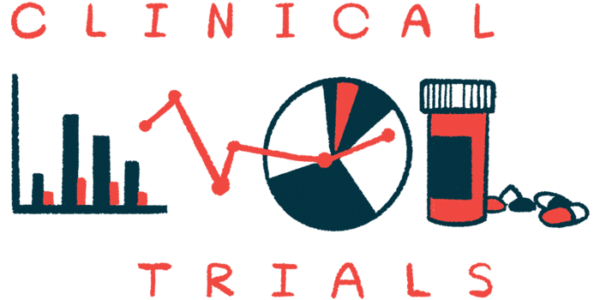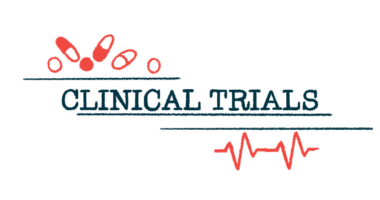Denifanstat seen to safely treat NASH in Phase 2b clinical trial
Treated patients show less disease activity; Phase 3 study planned

Denifanstat, Sagimet Biosciences’ experimental therapy, outperformed a placebo at resolving nonalcoholic steatohepatitis (NASH) — a severe form of fatty liver disease — without worsening liver scarring, or fibrosis.
That’s according to data from a Phase 2b clinical trial, called FASCINATE-2 (NCT04906421), in NASH patients with moderate to severe liver fibrosis.
“Denifanstat is designed to reduce the three main drivers of NASH, including fat accumulation, inflammation, and fibrosis, both independently and in parallel,” Dave Happel, CEO of Sagimet, said in a company press release.
Trial results “support denifanstat’s mechanism of action and the impact of addressing these multiple pathways simultaneously,” added Rohit Loomba, MD, a scientific advisor for Sagimet, gastroenterologist, and professor at the University of California San Diego.
NASH, a rising cause of liver cancer, lacks disease-targeted treatments
NASH, the fastest-rising cause of liver cancer worldwide, is a serious form of nonalcoholic fatty liver disease that’s marked by liver inflammation and fibrosis. After a nomenclature update by liver experts last year, nonalcoholic fatty liver disease (NAFLD) is now known as metabolic dysfunction-associated steatotic liver disease, and NASH as metabolic-associated steatohepatitis (MASH).
There currently are no approved treatments for NASH/MASH in the U.S. or Europe, and its management focuses mainly on weight loss to reduce the amount of fat in the liver.
Denifanstat is an oral therapy designed to block the activity of fatty acid synthase (FASN), a protein that makes fat in the liver. In preclinical models of NASH/MASH, it was shown to reduce fat buildup, lessen inflammation, and limit fibrosis.
“Denifanstat is the only FASN inhibitor currently in clinical development for the treatment of NASH with related fibrosis,” Loomba said.
Denifanstat previously was shown to reduce fat liver formation in a Phase 1 trial (NCT02948569) and to significantly lower liver fat and inflammatory and fibrotic markers in NASH patients within a Phase 2a trial, called FASCINATE-1 (NCT03938246).
The Phase 2b FASCINATE-2 study evaluated the experimental therapy’s safety and efficacy in 168 adults with biopsy-confirmed NASH/MASH and moderate-to-severe fibrosis.
According to trial data shared in a company webcast, most participants were in their 50s, about 60% were women, and about 90% were white.
Patients were randomly assigned to either an oral tablet of 50 mg denifanstat (112 patients) or a placebo (56 patients), taken daily for about one year. At the end of the study, liver biopsies were performed to assess liver inflammation and fibrosis.
The study had two primary goals. The first was to assess the proportion of patients with a reduction of at least two points on the NAFLD Activity Score (NAS) — indicating less disease activity — without fibrosis worsening. Results showed that more than half (52%) of patients on denifanstat met this goal, compared with 20% of those on a placebo.
The second main goal was the proportion of patients showing NASH resolution and a two-point drop on NAS, with no worsening of fibrosis. Again, denifanstat significantly outperformed a placebo (36% vs. 13%).
Decline in liver fat, fibrosis seen in NASH patients treated in clinical trial
Denifanstat’s superiority also was observed across several secondary goals involving liver health measures.
For example, the proportion of patients who had reduced fibrosis without NASH worsening was significantly higher with denifanstat (41% vs. 18%), as was the proportion of patients who had NASH resolution without fibrosis worsening, irrespective of NAS (38% vs. 16%).
In addition, the experimental therapy was associated with a significantly greater reduction in liver fat, fibrosis, and liver enzymes (whose high levels indicate liver damage).
“The [one-year] biopsy results showed that denifanstat achieved statistical superiority over placebo in reduction of fibrosis,” Happel said.
As in previous trials, no serious adverse events related to denifanstat treatment were reported in the Phase 2b study, and most adverse events were mild to moderate in severity. Skin and under-the-skin tissue problems, like dry skin, were the most commonly reported denifanstat-related side effects (22.3%), followed by eye disorders, like dry eyes (15.2%), and gastrointestinal issues (11.6%).
“The safety profile supports the further development of denifanstat in NASH patients,” Loomba said.
Sagimet is planning to meet with the U.S. Food and Drug Administration (FDA) to discuss next steps, with the goal of bringing denifanstat into Phase 3 testing later this year.
“Our next step will be holding an End-of-Phase 2 meeting with the FDA and starting our Phase 3 program for development of denifanstat in NASH with related fibrosis, which we anticipate to begin in the second half of 2024,” Happel said.







